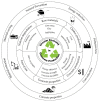Influence of Design Parameters on Fresh Properties of Self-Compacting Concrete with Recycled Aggregate-A Review
- PMID: 33339318
- PMCID: PMC7766624
- DOI: 10.3390/ma13245749
Influence of Design Parameters on Fresh Properties of Self-Compacting Concrete with Recycled Aggregate-A Review
Abstract
This article presents an overview of the bibliographic picture of the design parameter's influence on the mix proportion of self-compacting concrete with recycled aggregate. Design parameters like water-cement ratio, water to paste ratio, and percentage of superplasticizers are considered in this review. Standardization and recent research on the usage of recycled aggregates in self-compacting concrete (SCC) exploit its significance in the construction sector. The usage of recycled aggregate not only resolves the negative impacts on the environment but also prevents the usage of natural resources. Furthermore, it is necessary to understand the recycled aggregate property's role in a mixed design and SCC properties. Design parameters are not only influenced by a mix design but also play a key role in SCC's fresh properties. Hence, in this overview, properties of SCC ingredients, calculation of design parameters in mix design, the effect of design parameters on fresh concrete properties, and the evolution of fresh concrete properties are studied.
Keywords: design parameters; fresh concrete properties; mix design; recycled aggregates; self-compacting concrete.
Conflict of interest statement
The authors declare no conflict of interest.
Figures







Similar articles
-
Impact of Design Parameters on the Ratio of Compressive to Split Tensile Strength of Self-Compacting Concrete with Recycled Aggregate.Materials (Basel). 2021 Jun 22;14(13):3480. doi: 10.3390/ma14133480. Materials (Basel). 2021. PMID: 34206646 Free PMC article. Review.
-
Mechanical Performance Evaluation of Self-Compacting Concrete with Fine and Coarse Recycled Aggregates from the Precast Industry.Materials (Basel). 2017 Aug 4;10(8):904. doi: 10.3390/ma10080904. Materials (Basel). 2017. PMID: 28777316 Free PMC article.
-
Recycling Aggregates for Self-Compacting Concrete Production: A Feasible Option.Materials (Basel). 2020 Feb 14;13(4):868. doi: 10.3390/ma13040868. Materials (Basel). 2020. PMID: 32075141 Free PMC article.
-
Fresh-State and Mechanical Properties of High-Performance Self-Compacting Concrete with Recycled Aggregates from the Precast Industry.Materials (Basel). 2019 Oct 30;12(21):0. doi: 10.3390/ma12213565. Materials (Basel). 2019. PMID: 31671652 Free PMC article.
-
Impact of Recycled Aggregate on the Mechanical and Environmental Properties of Concrete: A Review.Materials (Basel). 2022 Feb 28;15(5):1818. doi: 10.3390/ma15051818. Materials (Basel). 2022. PMID: 35269048 Free PMC article. Review.
Cited by
-
Concrete Strengthening by Introducing Polymer-Based Additives into the Cement Matrix-A Mini Review.Materials (Basel). 2021 Oct 14;14(20):6071. doi: 10.3390/ma14206071. Materials (Basel). 2021. PMID: 34683659 Free PMC article. Review.
-
Recovery of Waste Materials: Technological Research and Industrial Scale-Up.Materials (Basel). 2022 Jan 17;15(2):685. doi: 10.3390/ma15020685. Materials (Basel). 2022. PMID: 35057407 Free PMC article.
-
Application of Artificial Intelligence Methods for Predicting the Compressive Strength of Self-Compacting Concrete with Class F Fly Ash.Materials (Basel). 2022 Jun 13;15(12):4191. doi: 10.3390/ma15124191. Materials (Basel). 2022. PMID: 35744253 Free PMC article.
-
Mix Design and Performance Study of High-Strength Self-Compacting Concrete with Manufactured Sand.Materials (Basel). 2024 Dec 26;18(1):55. doi: 10.3390/ma18010055. Materials (Basel). 2024. PMID: 39795700 Free PMC article.
-
Effect of Fiber Content on the Mechanical Properties of Engineered Cementitious Composites with Recycled Fine Aggregate from Clay Brick.Materials (Basel). 2021 Jun 13;14(12):3272. doi: 10.3390/ma14123272. Materials (Basel). 2021. PMID: 34199323 Free PMC article.
References
-
- Eurostat Recycling Rate of Waste Excluding Major Mineral Wastes. [(accessed on 24 April 2019)]; Available online: https://ec.europa.eu/eurostat/tgm/refreshTableAction.do?tab=table&plugin....
-
- Eusrostat Generation of Waste by Economic Activity. [(accessed on 3 February 2020)]; Available online: https://ec.europa.eu/eurostat/tgm/table.do?tab=table&tableSelection=1&la....
-
- Anefa . Informe de Situación Económica Sectorial. Madrid, Spain: 2018. [(accessed on 10 February 2020)]. Available online: https://www.aridos.org/wp-content/uploads/2018/10/Informe-sectorial-Asam....
-
- Padmini A.K., Ramamurthy K., Mathews M.S. Influence of Parent Concrete on the Properties of Recycled Aggregate Concrete. Constr. Build. Mater. 2009;23:829–836. doi: 10.1016/j.conbuildmat.2008.03.006. - DOI
-
- Fischer C., Werge M. EU as a Recycling Society Present Recycling Levels of Municipal Waste and Construction & Demolition Waste in the Europe. European Environmental Agency (EEA), European Topic Centre on Susatainable Consumption and Production; Copenhagen, Denmark: 2009.
Publication types
LinkOut - more resources
Full Text Sources
Research Materials

